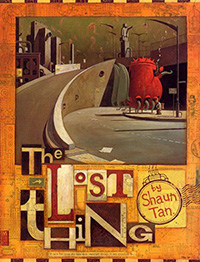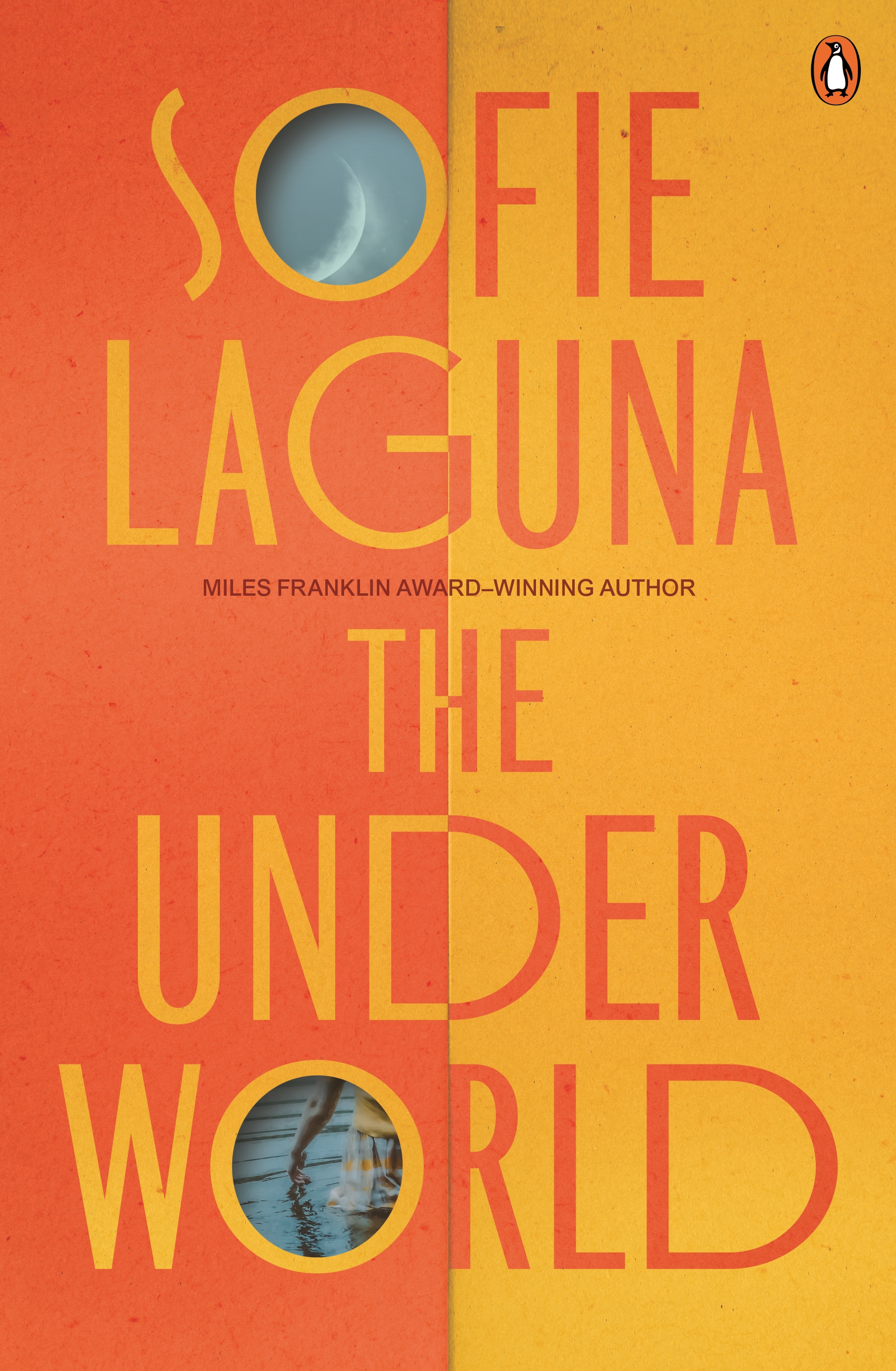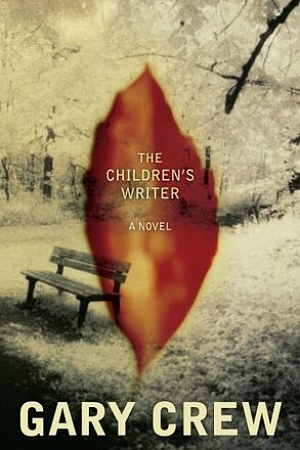Reading Australia: 'The Lost Thing' by Shaun Tan
Written and illustrated by Shaun Tan, The Lost Thing (2000) prompts readers to ask: ‘Who is this book for and what does it mean?’ Tan, in a personal email to the author, himself confesses that the work is a fable ‘about all sorts of social concerns with a rather ambiguous ending’, while the unnamed narrator of the story nonchalantly confesses: ‘don’t ask me what the moral is’. For these reasons, the reader may be forgiven for believing that the first-person narrator of The Lost Thing, represented in the illustrations as an ‘eraser headed’ young man, is possibly the author himself. But who knows, given that Shaun has declared of his work, ‘Just don’t ask the creator.’
The essential plot of The Lost Thing is based upon the rescue of a bright red ‘thing’ (a huge red teapot with legs? a hybridised marine crustacean with the body of a pot-bellied stove?) that the narrator has spotted sitting alone on a beach. Moved by compassion, he plays with it for hours before realising that it must be lost. The narrator takes the thing home to meet his family, lets it bunk down in a shed, and discovers that it loves consuming Christmas decorations. Next morning, having checked the ‘lost and found’ advertisements in the newspaper, to no avail, the narrator takes the thing to the ‘Department of Odds and Ends’ (whose enigmatic motto is ‘sweepus underum carpetae’) where, having filled in the obligatory forms while the thing makes a ‘small, sad, noise’, the narrator is mysteriously presented with an equally mysterious business card enigmatically embellished with an even more mysterious wavy line. With the thing in tow, the narrator sets out to search the cold and careless city for a place that might relate to the curious wavy line on the business card with which he has been presented. Having found such a place, he discovers it to be full of other seemingly contented ‘lost things’, and the big red lost thing ‘makes ‘an approving sort of noise’. Once the thing is farewelled and has settled to mingle with his other ‘no longer lost’ peers, the narrator goes home, philosophically observing, ‘I see that sort of thing less and less these days. Or maybe I’ve just stopped noticing. Too busy doing other stuff, I guess.’
Given the apparent nonchalance of the narrator, and the reader’s inability to gather any overt moral to the story, The Lost Thing asks more questions than it answers. That is the secret to much of Tan’s work. He openly confesses that in his illustrated books, very often two stories, visual and verbal, only ever run side by side as evidence of some other narrative that can’t actually be seen, read, or even talked about in ordinary waking life. (Possibly in the language of dreams? Who knows? Just don’t ask the creator!) This idea of word and image running ‘side by side’ is supported by Perry Nodelman in Words About Pictures: The narrative art of children’s picture books (1988). Nodelman argues that ‘words and pictures are quite separate from each other but ... placing them into a relationship with each other inevitably changes the meaning of both, so that good picture books as a whole are a richer experience than just the simple sum of the parts’.
The truth of the matter is that the real significance of the story lies in the space that the individual reader creates between the interrelation of the visual (illustrations) and verbal (printed words), which together form the ‘holistic text’ of the book. As Nigel Krauth says in Creative Writing and the Radical: Teaching and learning the fiction of the future (2016):
This type of book, which looks like a children’s book, grapples with adult themes in a complex and sophisticated manner, and represents a space for multimodal reading which is shared by children and adults. The emotional and intellectual depth of these books argues strongly against the old-fashioned idea that reading the pictures is not for the adult literary reader.
Maurice Sendak, internationally acclaimed creator of the illustrated book Where the Wild Things Are (1963), claims that ‘the invention of the picture book’ began in the art of Randolph Caldecott (1836–86) when he developed a ‘juxtaposition of word and picture, a counterpoint ... Words are left out and the picture says it. Pictures are left out and a word says it.’ Sendak states adamantly:
You must never illustrate exactly what is written. You must find a space in the text so that pictures can do the work. Then you must let the words take over where the words do it best. It’s a funny kind of juggling act, which takes a lot of technique and experience to keep the rhythm going ... You have worked out a text so supple that it stops and goes, stops and goes, with pictures interspersed. The pictures too, become so supple that there’s an interchangeability between them and the words; they each tell two stories at the same time.
In order to fully appreciate the ‘multimodal reading’ embedded in Shaun Tan’s The Lost Thing, the reader must search for meaning in the creative gaps between words and pictures, and pictures and words; to create as it were, a ‘third’ or individualistic interpretation of the book. That interpretation, unique to each reader as it will be, no doubt carries the genuine significance of both narrative and moral – if, as the narrator suggests, such a moral exists.
 The Lost Thing by Shaun Tan (Lothian Books/Hachette, 2000)
The Lost Thing by Shaun Tan (Lothian Books/Hachette, 2000)
Buy this book
The cover of The Lost Thing reveals an image of the thing and its gormless minder standing lost and alone at the entry to a typical soulless inner-city underpass. An immediate visual allusion to Jeffrey Smart’s famous painting Cahill Expressway (1962), it depicts a similarly dislocated male in a business suit standing in much the same dislocated position. Tan’s message in alluding to the painting is immediate and undeniable: city dwellers are lost, immersed in an anonymous and careless landscape of monumental concrete, towering over and reducing them. Tan drives his cover message home with an easily missed line in fine print beneath the title: ‘A tale for those who have more important things to pay attention to’. The narrator’s compassion for the lost thing denies this in the telling, although he does admit, when the thing is safely home at the end, ‘Maybe there aren’t many lost things anymore. Or maybe I’ve just stopped noticing. Too busy doing other stuff I guess.’ He goes home to what the reader is led to believe is the more urgent business of classifying his ‘bottle-top collection’.
Why is the reader unconvinced? What message is Tan actually relaying to his (no doubt) perplexed reader?
The works of other important visual artists alluded to in The Lost Thing should be mentioned to elucidate this mystery. In a cryptic, upside down, small-print reference relegated to the top of the last page of the book, Tan apologises to three major visual artists: Jeffrey Smart, Edward Hopper, and John Brack. Each of these artists has focused, at some point in his career, upon the dislocative elements of contemporary society, particularly in relation to city life and its ability to foster careless anonymity of the individual, albeit in a crowd. The allusion to Jeffrey Smart on the cover has been addressed, but John Brack’s Collins St, 5pm (1955) is clearly referenced by Tan when the lost thing is taken to the city on a tram. Weird looking though it is, not a head is turned. The stark, monumentally dispassionate cityscapes of Edward Hopper pervade Tan’s work, particularly visual allusions to Hopper’s stark Rooms by the Sea (1951) and the clinically dehumanised Office at Night (1946).
By recognising the existence of these adult visual allusions, we come a step closer to appreciating the depth and significance of Shaun Tan’s The Lost Thing. This is no picture books for a child’s bedtime reading, nor is it some reading primer of what Krauth refers to as ‘the “Dick and Jane” series 1927–1970’ which were ‘illustrated in the sense that the image is merely a replication of the text’. Considering the sophistication of the artists alluded to, one wonders who the intended readership of The Lost Thing really is: possibly any reader, irrespective of age, who has the emotional and creatively intellectual skills to negotiate the significance of the complex interplay between print and visual text – for all its initially apparent simplicity.
 The Lost Thing DVD (distributed by Madman Entertainment)By ‘print text’ the reader would be gravely misled if he or she read only the narrator’s words. It is the words that comprise the seemingly random confusion of nonsensical scientific and mathematical bricolage that surround the main images and narratorial text that really carry the full significance of the story. These nonsensical quotes (Have you any perpetual motion ideas?), meaningless formulae, and definitions (A perfect vacuum would be an absolute empty space) litter every page of the book. In fact, the main images and narratorial text appear to be pasted over them as if the narrator–creator is over-pasting a textbook he wishes to hide. Tan admits that ‘the nonsense formulae referred to are taken from his father’s physics and maths text books when he was an Engineering student and intended to give of the dry and industrial world presented in the paintings, a sort of meaningless functionality – pointless and amusing also’.
The Lost Thing DVD (distributed by Madman Entertainment)By ‘print text’ the reader would be gravely misled if he or she read only the narrator’s words. It is the words that comprise the seemingly random confusion of nonsensical scientific and mathematical bricolage that surround the main images and narratorial text that really carry the full significance of the story. These nonsensical quotes (Have you any perpetual motion ideas?), meaningless formulae, and definitions (A perfect vacuum would be an absolute empty space) litter every page of the book. In fact, the main images and narratorial text appear to be pasted over them as if the narrator–creator is over-pasting a textbook he wishes to hide. Tan admits that ‘the nonsense formulae referred to are taken from his father’s physics and maths text books when he was an Engineering student and intended to give of the dry and industrial world presented in the paintings, a sort of meaningless functionality – pointless and amusing also’.
In combining and interpreting all of these messages, whether in print text or visual image or allusion, the creative reader forms an individual sense of the meaning(s) of The Lost Thing.
For all of his apparent nonchalance and carelessness, the narrator does have family and friends. This doubtless encourages him to sympathise with the lost thing’s alienation, and leads him to befriend it. This in itself is a statement of selfless courage. Given the hideous appearance of the thing (if the book bore an olfactory element, I suspect the thing would exude an offensive odour akin to ‘prawns that had gawn orf’), the narrator takes a grave risk in sitting beside it at the beach and engaging in play. But he does. He also takes it home, feeds it, and finds it companionable accommodation with others of its kind. The subtext here is: ‘Hey, I’m a bit weird. I collect bottle tops. My folks are weird too. Check out their house. And my friend Pete is not exactly ordinary. We meet on his roof ...’ Given that this subliminal extraordinariness pervades the life of the narrator, it is easier for him to be non-judgemental and to reach out empathetically for others who are lost.
And what an environment to be lost in. I have read this book thousands of times and I cannot find a tree, leaf, flower, or garden. Yes, there is a beach, but its waters are acidic blue, overshadowed by monumental concrete walls seeping toxins. If the reader really looks, she will spot the word ‘MORE’ engraved in the concrete, meaning ‘MORE WHAT?’ The options are terrifying.
The agencies which are purportedly there to offer help (such as the cynically named ‘Department of Odds and Ends’) evidently achieve the reverse. The building itself dwarfs any prospective person (or thing?) seeking solace, reducing them to little more than spittle on the sidewalk. Indeed, even the disembodied voice advising the narrator suggests, ‘If you really care about that thing, you shouldn’t leave it here ...’
Whatever the intended audience of The Lost Thing, and whatever its moral or meaning, there can be little doubt that the book will provoke the conscience of its reader to be more aware of the human sympathies aroused for those among us who simply ‘don’t belong’.
Referenced works:
Crew, G. Strange Objects: 25 Anniversary Edition, with a foreword by Shaun Tan (2015)
Krauth, N. Creative Writing and the Radical. Teaching and Learning the Fiction of the Future in Multilingual Matters (2016)
Lanes, S. The Art of Maurice Sendak (1984)
Nodelman, P. Words About Pictures: The narrative art of children’s picture books (1988)











Comment (1)
Leave a comment
If you are an ABR subscriber, you will need to sign in to post a comment.
If you have forgotten your sign in details, or if you receive an error message when trying to submit your comment, please email your comment (and the name of the article to which it relates) to ABR Comments. We will review your comment and, subject to approval, we will post it under your name.
Please note that all comments must be approved by ABR and comply with our Terms & Conditions.